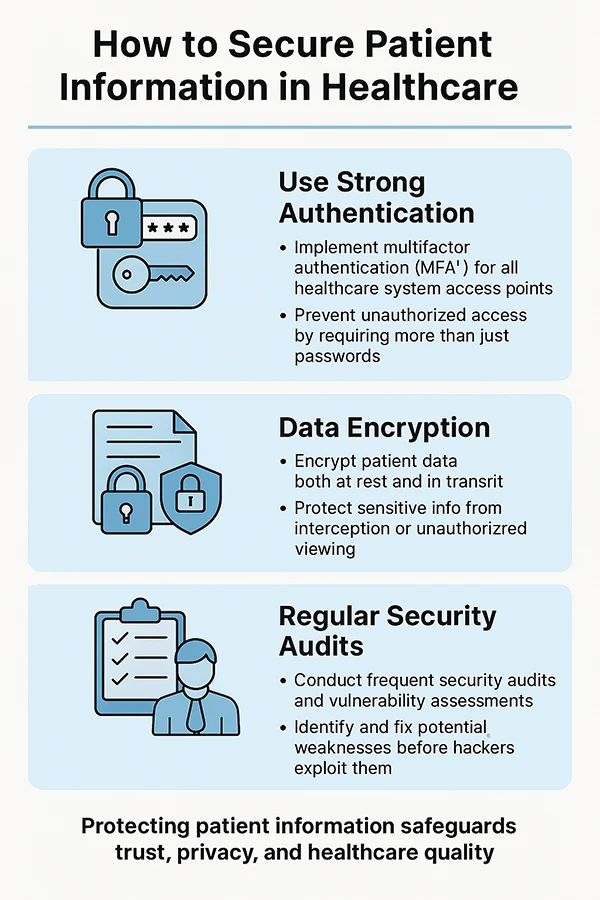Healthcare contains sensitive patient information that, if breached, threatens not only financial loss, identity fraud, and patient safety but also puts a layer cost on cybersecurity.
KEY TAKEAWAYS
- Healthcare breaches cost $11M; cybersecurity is more crucial than ever.
- AI systems improve care but remain vulnerable to cyber threats.
- Follow HIPAA, GDPR, and DSP Toolkit to ensure data compliance.
- Cyber liability insurance helps cover losses from data breach incidents.
- If patient data is lost or stolen, it can have a negative impact on the healthcare organization.

According to IBM’s 2024 Cost of a Data Breach Report, healthcare has the highest average cost of a data breach for the 13th year in a row–$11 million a breach. This statistic highlights how vulnerable clinical data has become to cyberattacks.
The growing importance of cybersecurity in protecting clinical data can’t be ignored. Hospitals and clinics amass tremendous amounts of sensitive patient data, which draws hackers looking for valuable information.
In this article, we will cover why healthcare systems are at greater risk today, what countermeasures healthcare organizations are implementing to protect their data. We will also discuss how organizations can better protect the information of their patients from digital breaches.
It’s no secret that healthcare providers maintain large quantities of essential patient information. This usually contains sensitive details like medical histories, personal, financial data, and more.
If, unfortunately, a data breach happens, it may cause financial scams, identity theft, and, most importantly, threaten patient care and safety. Luckily, several tools can be used to boost cybersecurity, such as multifactor authentication, encryption, and secure data storage. Below, you can see the best way to ensure data protection.

Speaking of the healthcare industry, lately, an innovation that turned out to be a major success (due to numerous benefits) is the AI doctor. It can offer patients personalized treatments, improved diagnostic accuracy, and significantly reduce human error.
But does it mean that it’s safe from cyberattacks? Health gurus at https://www.doctronic.ai/ would like to remind you that it’s susceptible to these threats, too! That’s because skilled and experienced hackers can easily exploit AI systems to perform actions that could be harmful to the patients.
Thus, individuals and organizations involved with artificial intelligence in healthcare need to give serious consideration to implementing a full complement of cybersecurity measures.
This includes, but is not limited to, advanced data encryption, routine security audits, multifactor authentication, intrusion detection systems, and secure access controls. These precautionary measures are used to protect sensitive clinical data, protect the system’s integrity, and mitigate the risk of future cyberattacks that may affect patient safety and trust.
Regulatory compliance is generally always recommended, particularly if you want to level up the cybersecurity in your facility. That’s because it establishes a vital baseline of protection, especially when using strategies such as access controls, data security standards, breach response plans, etc.
Even though all of these methods are very effective in terms of protection, sadly, there’s no guarantee that hackers and other virtual threats will be kept at bay all the time. After all, no system can be one hundred percent immune to them.
Healthcare organizations can enhance cybersecurity by adopting selected regulations, such as HIPAA (U.S.), NHS DSP Toolkit (U.K.), and GDPR (Europe), which present useful guidelines for safeguarding sensitive patient details.
PRO TIP Make sure to educate your staff about phishing awareness and secure handling of patient data to reduce risk.
As mentioned at the start, no industry is safe from cyber threats, meaning you should never question if your facility will be attacked, but when. It’s just a matter of time. Thankfully, there’s a tool that’s ideal for these purposes, which will ensure your healthcare institution is properly safeguarded.
It comes in the form of cyber liability insurance that offers a myriad of excellent coverage options to protect sensitive information from hackers, ransomware, etc. Furthermore, it includes all expenses that are related to cyberattacks on your facility.
These costs typically encompass things like lost income due to these attacks, the amount of money you need to spend to recover compromised data. They also cover costs related to notifying patients whose information was affected by a breach, and more.
As you can see, having something like this can greatly benefit you and your patients, hence it would be advisable to consider it.

Keep in mind that your healthcare institution doesn’t store irrelevant information, but highly sensitive data filled with important details. That’s why, if you are irresponsible as far as this is concerned, you can easily lose credibility.
If something like this occurs, your patients will perceive you as reckless and unprofessional, which will practically force them to seek care in other places, which will not only ruin your reputation but will result in major financial losses.
The healthcare sector is consistently dealing with massive breach expenses because it’s obviously a frequent target for hackers. Even if you haven’t been targeted by them yet, you still need to take all preventative measures to avoid ever facing them.
Healthcare contains sensitive patient information that, if breached, threatens not only financial loss, identity fraud, and patient safety but also puts a layer cost on cybersecurity.
Providers must comply with the requirements of HIPAA, GDPR, and the NHS DSP Toolkit. Compliance helps ensure that standards of security are identified and maintained so that patient information can be protected.
This type of insurance can pay for the loss of income caused by the cyberattack, cover the costs associated with restoring or recovering data, as well as patient notification costs associated with the breach. It provides greater protection to the institution.
